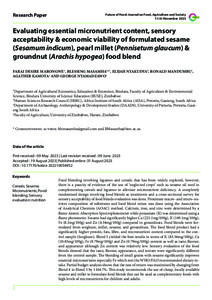| dc.date.accessioned | 2023-12-15T11:09:34Z | |
| dc.date.available | 2023-12-15T11:09:34Z | |
| dc.date.issued | 2023-08-31 | |
| dc.identifier | doi:10.17170/kobra-202210056952 | |
| dc.identifier.uri | http://hdl.handle.net/123456789/15298 | |
| dc.language.iso | eng | |
| dc.rights | Namensnennung 4.0 International | * |
| dc.rights.uri | http://creativecommons.org/licenses/by/4.0/ | * |
| dc.subject | cereals | eng |
| dc.subject | sesame | eng |
| dc.subject | micronutrients | eng |
| dc.subject | food blending | eng |
| dc.subject | sensory evaluation | eng |
| dc.subject | nutrition | eng |
| dc.subject.ddc | 300 | |
| dc.subject.ddc | 500 | |
| dc.title | Evaluating essential micronutrient content, sensory acceptability & economic viability of formulated sesame (Sesamum indicum), pearl millet (Pennisetum glaucum) & groundnut (Arachis hypogea) food blend | eng |
| dc.type | Aufsatz | |
| dcterms.abstract | Food blending involving legumes and cereals that has been widely explored, however, there is a paucity of evidence of the use of ‘neglected crops’ such as sesame oil seed in complementing cereals and legumes to alleviate micronutrient deficiency. A completely randomised design involving food blends as treatments and a cross-sectional survey for sensory acceptability of food blends evaluation was done. Proximate macro- and micro-nutrient composition of substrates and food blend mixes was done using the Association of Analytical Chemists (AOAC) method. Calcium, iron, and zinc were determined by a flame Atomic Absorption Spectrophotometer while potassium (K) was determined using a flame photometer. Sesame had significantly higher Ca (221.1mg/100g), K (149.1mg/100g), Fe (8.1mg/100g) and Zn (4.34mg/100g) compared to groundnuts. Food blends were formulated from sorghum, millet, sesame, and groundnuts. The food blend product had a significantly higher protein, fats, fibre, and micronutrient content compared to the control sample (Sorghum). Blend 5 yielded the best results in terms of K (83.56mg/100g), Ca (10.85mg/100g), Fe (8.79mg/100g) and Zn (0.79mg/100g) content as well as taste, flavour, and appearance although Zn content was relatively low. Sensory evaluation of the food blends showed that the taste, flavour, appearance, and texture were significantly different from the control sample. The blending of small grains with sesame significantly improves essential micronutrients especially Fe which met the WHO/FAO recommended dietary intake. Partial budget analysis shows that the rate of return was maximised by changing from Blend 4 to Blend 5 by 1164.7%. This study recommends the use of cheap, locally available sesame and millet to formulate food blends that can be used as complementary foods with high levels of micronutrients for children and adults. | eng |
| dcterms.accessRights | open access | |
| dcterms.alternative | The Evaluation of essential micronutrient content, sensory acceptability & economic viability of formulated Sesame (Sesamum indicum) & groundnuts (Arachis hypogea) : food blend formulation food blend for improved micronutrient intake among infants | eng |
| dcterms.creator | Marongwe, Farai Desire | |
| dcterms.creator | Masamha, Blessing | |
| dcterms.creator | Nyakudya, Elijah | |
| dcterms.creator | Mandumbu, Ronald | |
| dcterms.creator | Kamota, Agather | |
| dcterms.creator | Nyamadzawo, George | |
| dc.subject.swd | Sesam | ger |
| dc.subject.swd | Perlhirse | ger |
| dc.subject.swd | Erdnuss | ger |
| dc.subject.swd | Getreide | ger |
| dc.subject.swd | Mikronährstoff | ger |
| dc.subject.swd | Vermischung | ger |
| dc.subject.swd | Sensorische Prüfung | ger |
| dc.subject.swd | Ernährung | ger |
| dc.type.version | publishedVersion | |
| dcterms.source.identifier | eissn:2197-411X | |
| dcterms.source.issue | No. 4 | |
| dcterms.source.journal | Future of Food: Journal on Food, Agriculture & Society | eng |
| dcterms.source.volume | Vol. 11 | |
| kup.iskup | false | |
| dcterms.source.articlenumber | 340 | |


